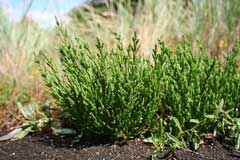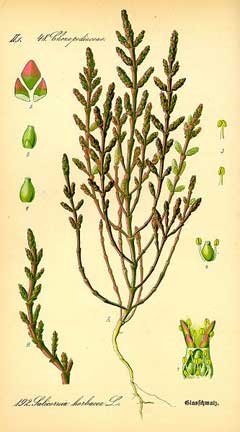 |
|
http://commons.wikimedia.org/wiki/User:Marco_Schmidt |
 |
| http://commons.wikimedia.org/wiki/File:Illustration_Salicornia_europaea0.jpg |
Translate this page:
Summary
Physical Characteristics

 Salicornia europaea is a ANNUAL growing to 0.3 m (1ft). It is in flower in August, and the seeds ripen in September. The species is hermaphrodite (has both male and female organs) and is pollinated by Wind.
Salicornia europaea is a ANNUAL growing to 0.3 m (1ft). It is in flower in August, and the seeds ripen in September. The species is hermaphrodite (has both male and female organs) and is pollinated by Wind.
Suitable for: light (sandy), medium (loamy) and heavy (clay) soils. Suitable pH: mildly acid, neutral and basic (mildly alkaline) soils and can grow in very alkaline and saline soils.
It cannot grow in the shade. It prefers dry or moist soil. The plant can tolerate maritime exposure.
UK Hardiness Map
US Hardiness Map
Synonyms
S. herbacea
Plant Habitats
Cultivated Beds;
Edible Uses
Edible Parts: Leaves Oil Seed Shoots
Edible Uses: Oil
Young stems - raw or cooked as a potherb, added to soups etc[5, 13, 52, 62, 183]. The plant is at its best for eating in late summer[264]. The stems are very succulent, but have a thin woody core that is easily removed[264, K]. They are best harvested when about 15cm long, the top 10cm being used leaving the bottom 5cm to produce new shoots[264]. They require little cooking, just adding them to a soup for the last few minutes of cooking is sufficient[9]. The plant has a salty flavour[183] and makes a very pleasant raw nibble[K]. The young shoots can be pickled after first boiling them in their own salted water[183]. Seed[105]. Rich in protein[183]. The seed is rather small and fiddly to utilize[K]. An edible oil is obtained from the seed. A high quality, it is similar to safflower oil (Carthamnus tinctoria)[183].
References More on Edible Uses
Medicinal Uses
Plants For A Future can not take any responsibility for any adverse effects from the use of plants. Always seek advice from a professional before using a plant medicinally.
None known
References More on Medicinal Uses
The Bookshop: Edible Plant Books
Our Latest books on Perennial Plants For Food Forests and Permaculture Gardens in paperback or digital formats.

Edible Tropical Plants
Food Forest Plants for Hotter Conditions: 250+ Plants For Tropical Food Forests & Permaculture Gardens.
More

Edible Temperate Plants
Plants for Your Food Forest: 500 Plants for Temperate Food Forests & Permaculture Gardens.
More

More Books
PFAF have eight books available in paperback and digital formats. Browse the shop for more information.
Shop Now
Other Uses
Cleanser Oil Potash
The ashes obtained from burning this plant are rich in potash and are used in making soap or glass[4, 6, 13, 46, 61]. The ashes can also be used as a soap.
Special Uses
References More on Other Uses
Cultivation details
Prefers a rich organic soil with ample nitrogen and regular watering[264]. This species is little, if at all, cultivated and its exact requirements are not clearly understood[264]. It is not known if the plant will require periodic inundation by salty water to grow well[264]. Glasswort is difficult to grow in cultivation[52, 264], it can succeed in gardens if sown as soon as the seed is ripe in the autumn in a well-drained soil[52]. A very variable plant both in size and the number of branches produced - a number of subspecies are recognised[264]. The best forms for food production are bushy plants up to 40cm tall with an upright habit that keeps the branches out of the mud[264]. The form sometimes classed as a distinct species (as S. ramosissima Woods.) has this habit and habitat and so is the best form for using in cultivation experiments[264]. When seeking seed for cultivation, try to collect from plants with this habit and also choose plants nearer the high tide mark that therefore receive less inundation[264]. The edible leaves are occasionally sold in local markets[46].
References Carbon Farming Information and Carbon Sequestration Information
Temperature Converter
Type a value in the Celsius field to convert the value to Fahrenheit:
Fahrenheit:
The PFAF Bookshop
Plants For A Future have a number of books available in paperback and digital form. Book titles include Edible Plants, Edible Perennials, Edible Trees,Edible Shrubs, Woodland Gardening, and Temperate Food Forest Plants. Our new book is Food Forest Plants For Hotter Conditions (Tropical and Sub-Tropical).
Shop Now
Plant Propagation
Seed - best sown in situ as soon as ripe in a well-drained outdoor bed[52].
Other Names
If available other names are mentioned here
Native Range
TEMPERATE ASIA: Afghanistan, Cyprus, Egypt (Sinai), Iran, Israel, Jordan, Lebanon, Syria, Turkey, Russian Federation-Ciscaucasia (Ciscaucasia), Azerbaijan, Georgia, Russian Federation (Dagestan), Russian Federation-Western Siberia (Western Siberia), Russian Federation-Eastern Siberia (Eastern Siberia), Kazakhstan, Kyrgyzstan, Tajikistan, Turkmenistan, Uzbekistan, Mongolia, Russian Federation (Primorye), China (Hebei Sheng, Gansu Sheng, Jiangsu Sheng, Liaoning Sheng, Shanxi Sheng, Shandong Sheng, Shaanxi Sheng, Qinghai Sheng, Nei Mongol Zizhiqu, Ningxia Huizi Zizhiqu, Xinjiang Uygur Zizhiqu), Korea, Japan TROPICAL ASIA: India EUROPE: Denmark, Finland, United Kingdom, Ireland, Norway, Sweden, Belgium, Czech Republic, Germany, Netherlands, Poland, Russian Federation-European part (European part (n. & s.)), Estonia, Lithuania, Latvia, Moldova, Ukraine (incl. Krym), Albania, Bulgaria, Greece (incl. Crete), Croatia, Italy (incl. Sicily), Romania, Slovenia, France (incl. Corsica) AFRICA: Egypt, Morocco
Weed Potential
Right plant wrong place. We are currently updating this section.
Please note that a plant may be invasive in one area but may not in your area so it's worth checking.
Conservation Status
IUCN Red List of Threatened Plants Status :

Growth: S = slow M = medium F = fast. Soil: L = light (sandy) M = medium H = heavy (clay). pH: A = acid N = neutral B = basic (alkaline). Shade: F = full shade S = semi-shade N = no shade. Moisture: D = dry M = Moist We = wet Wa = water.
Now available:
Food Forest Plants for Mediterranean Conditions
350+ Perennial Plants For Mediterranean and Drier Food Forests and Permaculture Gardens.
[Paperback and eBook]
This is the third in Plants For A Future's series of plant guides for food forests tailored to
specific climate zones. Following volumes on temperate and tropical ecosystems, this book focuses
on species suited to Mediterranean conditions—regions with hot, dry summers and cool, wet winters,
often facing the added challenge of climate change.
Read More
Expert comment
Author
L.
Botanical References
17
Links / References
For a list of references used on this page please go here
Readers comment